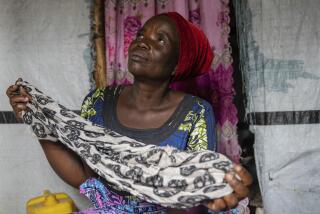Women’s Group Moved by Masai’s Plight : Charity: Eight O.C. residents help Kenyan tribe cope with poverty, high infant mortality.
- Share via
NAROK, Kenya — Patti Johnson grew up in Africa as the daughter of missionaries and has lived what she calls “a life of great adventure.” Yet the villages of Kenya’s Masai tribe were more than the Irvine woman expected.
“It was probably one of the most terrifying times of my life,” Johnson said in describing her first visit to the villages two years ago. A van dropped her off one morning in a village where the huts were made of dung and flies swarmed everywhere. “When I saw the van leave, I didn’t know if I could stay for five minutes.”
But she toughed it out, and returned to the Masai settlements last year, and again this year. With her this time were seven Orange County residents, members of Women of Vision, an organization Johnson, who is in her mid-40s, helped found four years ago to assist women in the Third World.
The group is an offshoot of a Christian group founded in 1950 that now runs humanitarian projects in 90 countries.
The Women of Vision members spent more than two weeks in Africa this summer, starting with two days at a slum called Soweto, in a suburb of Nairobi, the Kenyan capital. Then it was on to Masailand.
In Masailand, near Mt. Kilimanjaro and the border with Tanzania, World Vision runs a “child survival project” aimed at reducing the infant death toll. Social workers said mothers do not name their children until they are 1 year old because so many of them die before that.
It is a rugged land that makes it difficult for doctors or nurses to get there with basic services. Many of the women are married to the same husbands but care for each other like sisters, according to Michele McCormick, 35, of Irvine, who visited the area in 1990 and again this year.
It’s also a land familiar to readers of the National Geographic. For years, the picture of African tribes embedded in the Western subconscious was that of the Masai: tall warriors, hunting with spears, men required to slay a lion single-handedly to attain full manhood.
But for much of this century the picture has been outdated, according to historians. European colonialists took over land in the Great Rift Valley of Kenya and Tanzania traveled by wandering tribesmen; endemic syphilis depleted their ranks. But enough tradition remains to make the Masai exotic: men taking several wives or loaning a wife or two to other men; bridal dowry in livestock; a diet that includes the blood and milk of cattle.
With the colonialists gone, the rulers of independent Kenya, too, have tried to get the Masai to settle down, stop the migrations and take up farming. Their numbers dwindling, their territory shrinking, they bear more than a slight resemblance to the American Indians restricted to reservations.
And yet, said Johnson, they were better off than many others in Kenya.
“In comparison to Soweto, the needs of the Masai don’t seem to be quite so acute,” Johnson said.
That’s not to say they don’t have problems. Johnson said this year the major problem was that herds of elephants swept through the villages and ate the crops. A possible solution will be a fence, Johnson said, but it is up to the Masai to decide what is needed. Then Women of Vision will try to help.
The travelers spend at least a year after their trips helping with fund raising and have done well among the affluent of Orange County. Last year’s take was $200,000, Johnson said.
The Women of Vision paid about $3,000 each for the trip to Africa.
“Sometimes you’ll ask someone (to join the trip), and they’ll say, ‘Why should I take my vacation and go look at poverty?’ ” Johnson said. The answer is that it does something for the visitors as well as the visited, said Johnson. Which isn’t to say that traveling in the Third World is a walk in the park.
“My needs are simple,” Johnson said. “I was raised in the village, and I don’t need the Hilton all the time. But I have to always remind myself of where these women are coming from, not to expect them to be some place they’re not. It’s a choice for them.”
To prepare the travelers, the group sponsors trips to Tijuana and lecture series and slides on Third World women and development.
But there is nothing like seeing the Third World for the first time for a person from a developed nation.
“The poverty was shocking,” said McCormick, a clinical psychologist who practices in Newport Beach and made her first trip to Africa with Women of Vision two years ago.
Even the capital, a nation’s showplace, was “rundown and dirty. The areas where people were living, the apartment buildings, were so much like slums.” Equally daunting was the sight of soldiers with machine guns patrolling the streets, McCormick said. Political instability flares in the nation and the U.S. State Department periodically issues warnings against traveling in some areas, she said.
But McCormick said she felt safer in the countryside. And wherever she went, like Johnson, she was buoyed by the people’s sense of community and high spirits in the face of poverty.
“I guess I was just shocked to see that people live so primitively and with so little and such adversity and they seem so alive in the midst of it,” McCormick said. “And here we’ve got so much and we seem so dead. And we’re not a community; we’re so isolated.”
Times staff writer John Needham contributed to this story.
More to Read
Sign up for Essential California
The most important California stories and recommendations in your inbox every morning.
You may occasionally receive promotional content from the Los Angeles Times.










